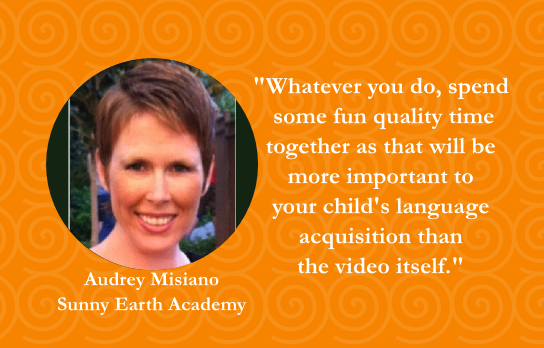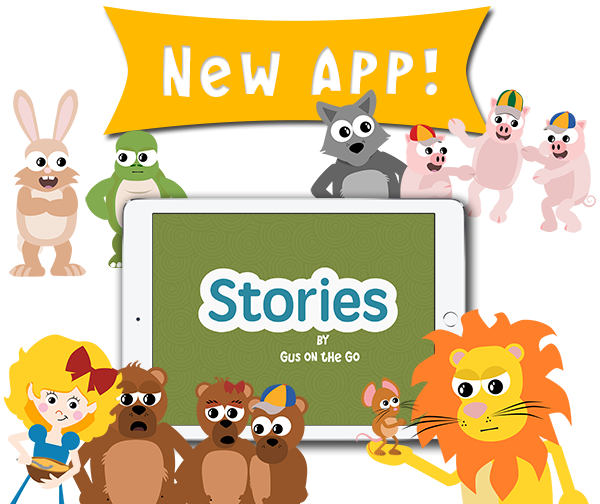
Audrey Misiano teaches French and Spanish using AIM Language Learning to 7th and 8th grade students in Central New York. She has a BA in French Language and a Masters in French Literature, and was a Fulbright Scholar teacher at the Université Libre de Bruxelles where she also studied Spanish. Audrey enjoys incorporating technology into her classroom and loves sharing what she knows. She creates and uses videos to help promote bilingualism and to flip lessons in her AIM classroom.
Videos have been a large part of my life for about a decade now. The first video I made was for an education class. I learned iMovie and have been creating videos ever since. It wasn’t until June 2011, however, that my use of video really started positively effecting my life. This was when I created my first video channel on YouTube. I have since created and uploaded hundreds (possibly thousands) of videos on my various channels. This TED talk was an inspiration to me at first, as was Sylvia Duckworth. Then I started uploading videos of my children and students and then they became my inspiration! What I found was that videos can be an engaging and motivating force in both the bilingual home and the World Language classroom. I now use video to help teach my children and students and their language acquisition is definitely benefiting!
It is important to remember that you cannot simply put a child in front of a screen and expect them to learn. Therefore, I have compiled a list of my top 5 tips for incorporating videos into the lives of children acquiring a language:
1. ENGAGE – Videos must engage the child to promote acquisition
This may seem like common sense, but sometimes I feel as a parent, I assume my children are going to like a cute animated video because I think it’s fun…but that is not always the case. If the child isn’t fully engaged, and interested in what they are watching, then the video has very little or no positive effect on their language acquisition. We also must remember something that is engaging for one child may not be for the next. I have learned to check with my children before creating a new educational game, story, song, app-animation, or video to share on my YouTube Channel or Teachers pay Teachers store. If neither of them like the idea, I know I have a lot of work to do!
2. PARTICIPATE – Audience participation is a bonus
Whenever a video elicits your child to participate, that is a bonus for their language acquisition. What I look to see in my children as they watch a video is for them to be so curious they want to stop and ask questions. I want to see them singing the theme song and standing up to dance along when the characters do. I want to see them participate in some manner that shows they are engaged and they comprehend what is going on. Such participation is not mandatory for acquisition to occur, but I cannot help thinking it is a very good bonus for your little linguist! Your child will find the video even more memorable if you are able to participate alongside him or her!
If you’d like some interactive French or Spanish videos that will entice your child to participate, please visit my French and Spanish Kinesthetic Video playlists on my channel! I have also created an interactive Easter egg video story where children can count along and do simple math problems. You can find it in English and Spanish in my TpT Store. I also find that predictable video stories encourage participation, such as this Halloween story (Full story on TpT).
3. INTERACT- Combine videos with human interaction
People acquire language from human interaction and not from videos. However, videos are an incredible way to supplement your child’s language acquisition! Use the videos as a starting point, pausing often to discuss what just happened in the target language. If the video follows tips 1 and 2 above, then you will be at no loss to find ways to engage your child both before, during and after the video in the target language! If you are watching a video series (my children are currently watching Ontario’s “Telefrançais“) then you can ask questions about what they remember from the last video and ask them to predict what may happen this time. If they have never seen the video, you can show them the first few seconds and then pause it to ask them to predict what the video is about. You could even learn something from a video and then perform it with your child, recording yourselves. Then you can refer back to the video from time to time to share a fond memory of the fun learning time you had together! You could also use apps to create your own videos or animations together. As your children grow, it’ll be fun to look back at them to see how far they have come in their language skills! Here’s some examples of video souvenirs created together with children learning English and French.
4. CHALLENGE – Videos should be a little above the child’s current language ability.
“The input hypothesis states that learners progress in their knowledge of the language when they comprehend language input that is slightly more advanced than their current level. Krashen called this level of input “i+1”, where “i” is the language input and “+1″ is the next stage of language acquisition.” (Wikipedia)
This seems to make sense, doesn’t it? Unless you are providing your child with something that has at least a little new content for them, they will not progress. It is not a good idea to have them watch videos that are way above their level of ability, unless the video is so completely and utterly engaging to your child that they just don’t care whether or not they understand it. I highly recommend creating your own YouTube Channel, as I have here, even if you don’t plan on uploading any videos. You can learn the basics on how to get started with YouTube by checking out this amazing document created by Sylvia Duckworth. If you are teaching your child French, be sure to check out Sylvia’s awesome channel here! She has a lot of amazing uploads both original and where she has added French subtitles, like this adorable one about “Petit-Bleu et Petit-Jaune” she also has a lot of amazing playlists!
Creating a channel allows you to make playlists, and there’s no limit to how many you can make. So if your child is really interested in dinosaurs and trains this year, and s/he is just beginning to learn a second language, you could create a dinosaur and train playlist for beginners in the language. As your child progresses, you can make a new playlist for their new level of ability or add videos onto any playlist at any time. Creating playlists also provides parents with the chance to preview videos and then share the videos with your child knowing full well that they are appropriate for their language level and interests. I create playlists on my iPad’s YouTube app, then use my Google Chromecast to allow my children to watch the playlists on the television.
A good place for you to start finding videos for your young child in English, French, or Spanish may be these three playlists I’ve put together over the years: French for young learners, English for young learners, and Spanish for young learners.
5. RELIVE – We’ve watched some videos…Now what?
After the video is watched and the content is learned, be sure to use what you’ve learned in your day-to-day life with your child. The real-life interaction with the language is what will allow children to acquire the language and keep it with them for the rest of their lives. If the video teaches a certain skill like counting or colors or food, then make it a point to incorporate those words into your daily life, even if it means learning along with your child. Whatever you do, spend some fun quality time together as that will be more important to your child’s acquisition than the video itself.
Additionally, it is also a good idea to REPEAT the videos your child enjoys most. I know that when my children find one they adore, they can watch it a dozen times! This is a wonderful thing for language acquisition as it provides a healthy amount of pleasant repetition which is necessary for acquisition to occur.
Above and beyond everything else, remember to have fun with language with your little ones and those good feelings will do a world of good for your child’s language acquisition!
You can connect with Audrey through her video channels, on twitter (@AudreyMisiano) and she can also be reached at amisiano1@gmail.com.




